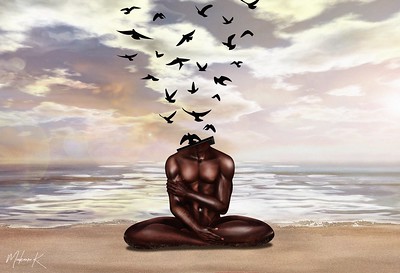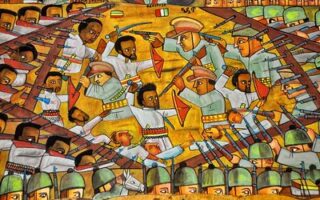Introduction
Mental health and illness are seen throughout the world. But the way mental health impacts the social life and culture of many countries varies as well. One thing for sure, the World Health Organization states that the global economy loses about $1 trillion (USD) per year in productivity due to depression and anxiety. But the economic loss is even greater in developing countries that have less funding to treat mental illnesses. According to Cambridge graduate, Alexandra Caulfield, she reflects on Professor David Ndetei of the Africa Mental Health Foundation as he describes the outlook for mental health in Kenya:
70% of African countries earmark less than 1% of their national
health budget for mental health services…it is estimated that 90%
of mental health disorders in these countries go untreated, despite
the fact that they are home to 85% of the world’s population”.
[Yet], of the [54] African countries, seven are without a psychiatrist,
12 without psychologists, 12 without social workers, and 11 without
psychiatric nurses.
The striking divide of aid for mental health in Africa compared to western countries are impacted by historical, social, and economic factors. The goal of the final paper is to elaborate on the stigma and treatment of mental health and illness in Africa. To explain this topic, mental illness will be defined in relation to a European and African definition. During this section, it will explain how this has impacted and did impact Africa’s social dynamics. Next, the role of missionaries and surgical evangelism among the Yoruba will be discussed. Finally, the biography of Saran Keita will be dissected in order to show the lifestyle of one with an illness, both physical and mental. The main theme for the paper will be about how the stigma of mental illness in relationship with religion was shifted after colonization, and to compare how Africans identified and handled mental illness and/or health before and after European influence.
The World Health Organization, “primary role is to direct and coordinate international health within the United Nations system. Our main areas of work are health systems; health through the life-course; noncommunicable and communicable diseases; preparedness, surveillance and response; and corporate services”. They divide mental health into six regions, one region called the African region. This already presents suspicious, because Africa is a huge continent with diverse languages and cultures. One definition and example of mental health may differ from another. By placing all of Africa under one definition, dismisses the diversity of the African people and cultures. Mental illness is a subjective term that various across cultures, regions, and geographic regions. But according to the National Alliance on Mental Illness, mental illness is a condition that affects a person’s thinking, feeling or mood and how this affects their day to day life. Knowing how pivotal mental health is in society, colonizers used mental health as way to gain and maintain colonial power. In order to gain dominance and superiority, colonizers and western missionaries shifted how certain illnesses were identified, cured and who could cure them.
Mental Health in the West
In order to compare the shift in mental health terminology, one must first know how mental health was identified and treated. The insane asylum was an innovation of the 19th century that contained only the mentally ill. Twenty years before the reinvention of the asylum, the mentally ill would face the punishment of the family and community or madhouse with other castoffs of society. The new asylums aimed at medically treating and rehabilitating patients through methods that affected the mind. These practices began the field of psychiatry. As a result, this practice spread across Europe and hundreds, mostly those of lower classes, were sent to public asylums. The doctors and physiatrist reveal more than patient’s diagnosis, they reveal about “themselves-their medical categories, social prejudices and concerns, and cultural background-as it does of their patients…it was thus middle-class groups who initially developed the new vision of insanity, largely in reference to their own health and identity (Goldberg, 1999). Because the west was a government system that practiced capitalism, the more money you had, the more power you had. Because the wealthy were in place of diagnosis, they determined the way something was identified and cured for everyone. This makes the field narrow-minded as the similar type of people and backgrounds define the forms of mental health. As well as truly identifying and relating to their patients despite their differing social class.
Mental Health in Africa
The identification of mental is difficult to identify for all of Africa, because the continent is so geographically large, that it caters over a hundred languages, cultures, and history. Throughout this paper, to narrow down the definition of mental health and illness, the Yoruba people will be discussed. The Yoruba people one of the largest ethnic groups in southwestern Africa that are located across Benin and Nigeria, with a population of 44 million people. But in 1901, Yorubaland was colonized by the British and adopted a system of indirect rule. Soon, in 1906, asylums were built and operating. Two being the Yaba Lunatic Asylum (later, Mental Hospital) in Lagos and Aro Mental Hospital in Abeokuta. Although this region government system was indirect rule, the British administration still had direct influence and power of the Yoruba people. The goal of colonization was to gain land and wealth. With a capitalist mindset, those that did not contribute to income, were more likely to be placed in an asylum, the poor, outcast, and those showing extreme cases of cultural differences, one being nudity.
In Europe, nakedness was a state of vulnerability, whereas nudity was, “not of a huddled and defenseless body, but of a balanced, prosperous, and confident body” (Robert, 2013). If someone was naked, that was seen as a personal choice, resulting in embarrassment. But the Yoruba had the opposite definition of nakedness. The relationship between nakedness and madness are so closely tied together, that the Yoruba gave it its own diagnostic category, “madmen who wears clothes”. By wearing clothing, the Yoruba believed that a person that could dress could also conceal their madness. By contrasting the identities of nudity in the West and Yoruba, one can see the clear difference among cultures. The European ideas of nakedness shifted the culture of nudity into the objectification of women and widen the gender hierarchy among women and men in Yoruba. John Berger argues how nudity seen in art works are a battle representation of the sexes. Berger states that:
Men act and women appear. Men look at women. Women
watch themselves being looked at. This determines not only
most relations between men and women but also the relation
of women to themselves. The surveyor of woman in herself
is male: the surveyed female. Thus she turns herself into an
object—and most particularly an object of vision: a sight.
Although this quote is referring to the gender hierarchy in art pieces, this is still relevant to how western painters viewed women. This idea of nudity and objectifying women was a way for western colonizers to shift the culture and gender dynamics that worked in their favor; resulting in the transformation of gender roles, status, and power among women.
Religion and Mental Health
Religion plays an important role in religion to the Yoruba people. The Yoruba identify some who is ill as one who may severely harm themselves or cause harm to the community. Westerns divide mental illness from religion. While the Yoruba do not. The incorporation of their 401 deities, magic, witchcraft, and supernatural interpret how a patient is diagnosed. The Yoruba are a community-based society. The actions of one, effect all. That is why individual responsibility is enforced, if not, you may be cursed and possessed by an evil spirit. If witchcraft was used, the following would be produced: bad dreams (the feeling of falling or being chased), sleeplessness, restlessness, worries, sterility, stomach pains, headache and skin sores. The possession of magically disturbances was regarded as an illness by the Yoruba (Sadowsky, 1999). To get rid of an illness, one would visit a traditional healer. The Healers would, “treat psychiatric aliments through a combination of rituals, consultations with family members and herbal medicines, especially the plant Rauwolfia” (Sadowsky, 1999). These rituals and herbal medicines were intended to serve ancestors and spirits, yet westerns have intended to commercialize these practices and healing secrets.
The excuse for colonizing was to gain wealth (commerce), civilization, and Christianity. The first phase of colonization began when western missionaries traveled to Africa. Many missionaries were amateur, non-trained white men, “who carried medical bags, their identity, Ngaka, was strengthened…when missionaries connected healing with salvation people seemed to understand them” (Landau, 1996). These missionaries promoted Christianity and used the religion as a way to convert many Africans to Christianity and away from using their beliefs and practices toward medicine. This was called surgical evangelism, and this concept began to shift how African treated and cured their patients. Missionaries controlled what disease/illness was “dangerous” due to their cultural western beliefs of practicing Allopathic (meaning counter disease). Especially eliminating diseases that gave Africa the reputation of “White Man’s Grave”, such as malaria, sleeping sickness, and smallpox (Ngalamulume, 2013). For example, the social stigma of leprosy and western treatment of lymphatic filariasis (elephantiasis). By gaining power in the medical field, one gained a higher social power. The more a person specialized in healing, the higher was their social status. Consequently, this shifted and lowered the social role and status of traditional healers in a post colonialist society where western medical centers are controlling.
The Hidden Illness of Saran
The biography of Saran Keita is told in the first chapter of “People Are Not the Same” by Eric Silla. The chapter tells the story of Saran, a Malinke woman born around 1915 living with leprosy in rural Mali. The main questions the author ask his readers are to examine the social reactions toward Saran. Although the reader can easily translate Saran’s life living with leprosy was impacted differently because of her gender and ethnicity, the author, Silla, does not dive down into the mental health of Saran during her life (Cleaveland, 2000). This section will discuss Saran’s isolation being a factor for developing depression and consequently turning to western medicine for aid.
The National Organization of Rare Disorders defines leprosy as, “a chronic infectious disease of humans caused by the bacteria Mycobacterium leprae. For many years, it was considered a mysterious disorder associated with some type of curse, and persons with the disease were isolated and ostracized”. In Saran’s village, leprosy was called Banaba, the “big disease”, and many thought it could spread to them. In order to prevent this, those with leprosy were isolated from their homes and their social status was tarnished. When a reddish patch (called bilen) appeared on Saran’s forehead, she was taken to a reputable healer who identified the now blistering skin as banaba a few days later. Saran’s husband, Janko kicked her out of his household in fear of the disease spreading to him. Ashamed to return home to her family, for two years, Saran lived outside the village in isolation and was shunned as:
The people in Tigu didn’t want a leper walking around their village.
They prohibited her from eating meat or fish, claiming that those foods
would aggravate her condition. Saran became increasingly withdrawn
and preferred the seclusion of the bush to the community of others in
which she felt so much maloya (shame) (Silla, 1998).
Because of leprosy, Saran’s social and gender status were lowered. Because of the isolation, she was unable to perform her female and wifely duties such as prepare and serve meals along with other adult women. Visitors and friends no longer visited, she could not participate in women’s social activities, she was encouraged not to marry again, and had to eat meals alone with her sister who was also a leper. This social treatment and isolation were the perfect formula for depression. Eric Silla does not delve into Saran’s two years of isolation other than explaining the social consequences of her leprosy. Throughout Saran’s two years, Saran most likely suffered from depression as a result.
In the scholarly article, “Relationship Between Loneliness” beautifully state that, “human beings are social species which require safe and secure social surroundings to survive. Satisfying social relationships are essential for mental and physical well beings.” During Saran’s isolation, she was trying to avoid being seen by her husband who would steal her food and beat her. Saran lacked a safe and social environment for her to thrive and this impaired lifestyle lead to the psychiatric disorder depression. Mali (Saran’s location) and Benin (one of the Yoruba countries) are close to proximity, so they possibly shared many characteristics, one being medicine. In the Yoruba language, “depression seems to be an unfamiliar concept and there is linguistic difficulty in finding Yoruba words with which to describe the subjective feelings meant by the term” (Leighton et all., 1963). By isolating those with diseases, people may not have known the unintended consequences, such as depression. It now comes into question on how many Yoruba may have suffered from depression, especially if there was not word to describe their emotions and feelings.
Loneliness and depression share many symptoms, that many relate the two. The only difference being that loneliness “is characterized by the hope that all would be fine, if the lonely person could be united with another” (Mushtaq et all., 2014). Once Saran received medical assistance from the toubabs (Europeans), Saran’s persistence and determination seemed to keep her going in life, thus ending her depression as she was able to redefine her identity among a new community. After going to multiple traditional healers, Saran’s condition did not improve until the intervention of the toubabs and their medicine. Saran’s story is an example of how powerful surgical evangelism spread throughout Africa. Many Africans who were cast out of society turned to European missionaries for assistance. As their medicine proved effective, they gained more Christian followers and they continued to spread the Christian message, and ultimately their rule, power, and culture throughout Africa. Effective help from missionaries went parallel with European rule. Saran says that under the toubabs rule, everyone, even lepers like herself, were able to support themselves and feel accepted and valued.
Conclusion
Mental health in Africa is a huge topic that cannot be categorized into one category. Many factors play a role in defining it, treating it, and preventing it. This paper was an introduction to showcase how colonization impacted the social and cultural identity of mental health and illnesses. To begin, the definitions of mental health and illness in relation to European and African (specifically the Yoruba) standards was discussed. In European culture, those with mental illness were placed into asylums and introduced this concept to Africa after colonization. The example given to support this argument was the idea of nudity. If one was nude in Europe, one was to be embarrassed and considered a lunatic. Whereas in Yoruba culture, clothing was a way to cover your madness. A reasoning behind colonization was to spread Christianity. European missionaries spread the gospel, as well as their European beliefs. One of them being, their medical practices being superior. By using surgery and other forms of treatment to cure Africans, they were surgically evangelizing their patients, consequently shifting the role of traditional healers in the social hierarchy. Finally, the biography of leprosy patient Saran Keita was discussed, as her story discussed the social impact and shift from colonialism among the diseased. To further explain Saran’s story, the suggestion of Saran having depression due to her forced isolation was discussed. Colonizers implantation of their ideas on different African countries ignores current cultural practices and deeming European ideas as superior. In regards to mental health, this shifted how Africans viewed the idea of what diseases were dangerous or not due to European standards. By controlling how a society believes, ultimately kept European colonizers in power and control at the expense of African culture.
References
10 facts on mental health. (2019, October 2). Retrieved from https://www.who.int/news-room/facts-in-pictures/detail/mental-health.
About WHO. (2019). Retrieved December 11, 2019, from https://www.who.int/about.
Caulfield, A. (2015, October 22). Mental health in Africa-challenges and progress since 2008. Retrieved December 11, 2019, from https://blogs.bmj.com/bmj/2015/10/22/mental-health-in-africa-challenges-and-progress-since-2008/.
Cleaveland, T. (2000). Book Reviews . African Studies Quarterly , 4(1), 43–45. doi: 10.1163/_afco_asc_799
Goldberg, A. (1999). Sex, religion, and the making of modern madness: the Eberbach Asylum and German society, 1815-1849. New York: Oxford University Press.
Landau, P. S. (1996). Explaining Surgical Evangelism in Colonial Southern Africa: Teeth, Pain and Faith. The Journal of African History, 37(2), 261–281. doi: 10.1017/s0021853700035222
Langwick, S., Rottenburg, R., & Zenker, J. (n.d.). The modernisation of traditional healing in South Africa healers, biomedicine and the state.
Leighton, A. H., Lambo, T. A., Murphy, C. C., Leighton, D. C., Murphy, J. M., & Macklin, D. B. (1963). Psychiatric disorder among the Yoruba: a report from the Cornell-Aro mental health research project in the Western Region, Nigeria. Ithaca, NY: Cornell University Press.
Leprosy. (n.d.). Retrieved from https://rarediseases.org/rare-diseases/leprosy/.
Ngalamulume, K. (2013). Health, Medicine, and the Study of Africa. Oxford Bibliographies Online Datasets, 163–231. doi: 10.1093/obo/9780199846733-0050
Sadowsky, J. (1999). Imperial Bedlam: institutions of madness in colonial southwest Nigeria. Berkeley: Univ. of California.
Silla, E. (1998). People are not the same: leprosy and identity in twentieth-century Mali. 29-41. Portsmouth, NH: Heinemann.
Mushtaq, R., Shoib, S., Shah, T., & Mushtaq, S. (2014). Relationship between loneliness, psychiatric disorders and physical health ? A review on the psychological aspects of loneliness. Journal of clinical and diagnostic research : JCDR, 8(9), WE01–WE4. doi:10.7860/JCDR/2014/10077.4828
Yoruba – Art & Life in Africa – The University of Iowa Museum of Art. (n.d.). Retrieved from https://africa.uima.uiowa.edu/peoples/show/Yoruba.



